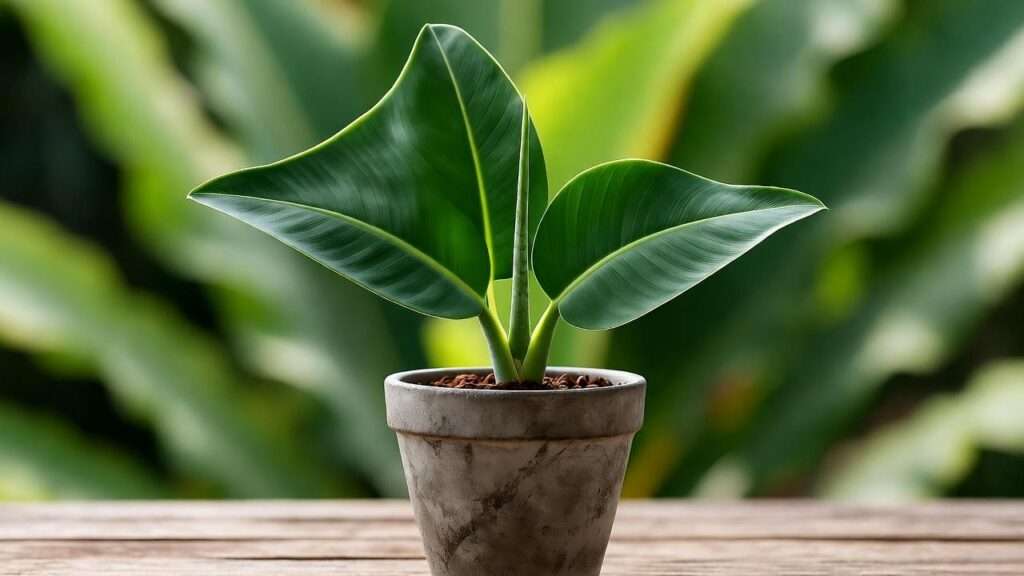Imagine a creature from the deep, gliding silently through your living room. That’s the feeling the Alocasia macrorrhizos ‘Stingray’ evokes. With its massive, arrow-shaped leaves ending in a pointed tail and supported by elegantly mottled, Alocasia zebrina-like stems, the Stingray Plant is arguably the most sculptural and dramatic houseplant you can own. It’s a true centerpiece, blending exotic mystery with modern minimalist design.
H2: The Stingray Sensation: Why This Alocasia Demands Attention
While the Stingray Alocasia is highly sought after by collectors, it has earned a reputation for being a dramatic diva. Many plant enthusiasts struggle to keep its signature leaves standing tall, often finding them drooping or yellowing without warning. The search intent behind this article is clear: you want to master Stingray Plant Care, minimize the drama, and maximize its stunning foliage.
- Scientific Context (E-E-A-T): This distinctive plant is a highly prized cultivar of Alocasia macrorrhizos, a common “Elephant Ear.” The ‘Stingray’ mutation features exaggerated leaf morphology that makes it unique among its peers.
- The Promise: This comprehensive, expert guide will move your Stingray Plant from a temperamental challenge to a thriving masterpiece. We’ll show you exactly how to replicate its ideal native conditions.
- Search Intent Fulfillment: We will demystify the famous Alocasia ‘drop’ and show you how to maintain maximum leaf count, providing you with the confidence to grow this tropical wonder successfully.
🔬 Section 1: Decoding the Alocasia ‘Stingray’ — Botanical Profile
To effectively care for any plant, you must first understand where it comes from. This is the foundation of true plant expertise and forms the basis of the E-E-A-T framework for quality content.
H2: Understanding Your Stingray Plant’s Tropical Roots (E-E-A-T Foundation)
The Alocasia genus thrives in dynamic, rainforest environments, and the Stingray is no exception. Understanding these conditions helps us reverse-engineer the perfect indoor habitat.
- H3: Native Habitat and Growth Cycle The wild ancestors of the Alocasia macrorrhizos ‘Stingray’ originate in the humid, tropical, and subtropical rainforests of Southeast Asia (specifically Borneo, Philippines, and parts of Australia). This tells us three critical things about its fundamental needs:
- High Heat & Humidity: It requires consistently warm, moist air year-round.
- Dappled Light: It thrives under the canopy, receiving bright, indirect, and filtered sunlight, never harsh midday rays.
- Constantly Loose, Organic Soil: In the wild, its roots grow in nutrient-rich, rapidly decomposing leaf litter—a medium that is highly aerobic and drains instantly. This is the primary clue for solving root rot problems indoors.
- H3: The Tuber/Corm: The Plant’s Battery 🔋 Unlike many common houseplants, Alocasias grow from a corm (often referred to as a tuber or bulb). This corm is the plant’s strategic reserve, acting as a massive battery for storing energy, starches, and water.
- Crucial for later troubleshooting: When an Alocasia encounters unfavorable conditions (like cold, drought, or shock), it doesn’t just die—it sheds all its leaves and retreats to the corm to wait for better times. This is the plant’s self-preservation mechanism, known as dormancy. A firm, healthy corm means your plant is still alive, even if it has no leaves.
- H3: Toxicity Note (Safety First) As a member of the Araceae family (Aroids), the Stingray Plant contains calcium oxalate crystals. These crystals, if chewed or ingested, cause painful irritation, swelling of the mouth and throat, and digestive issues. While not typically lethal, the plant is toxic and should be kept safely out of reach of curious pets and small children. Always wear gloves when pruning or handling the plant to avoid skin irritation.
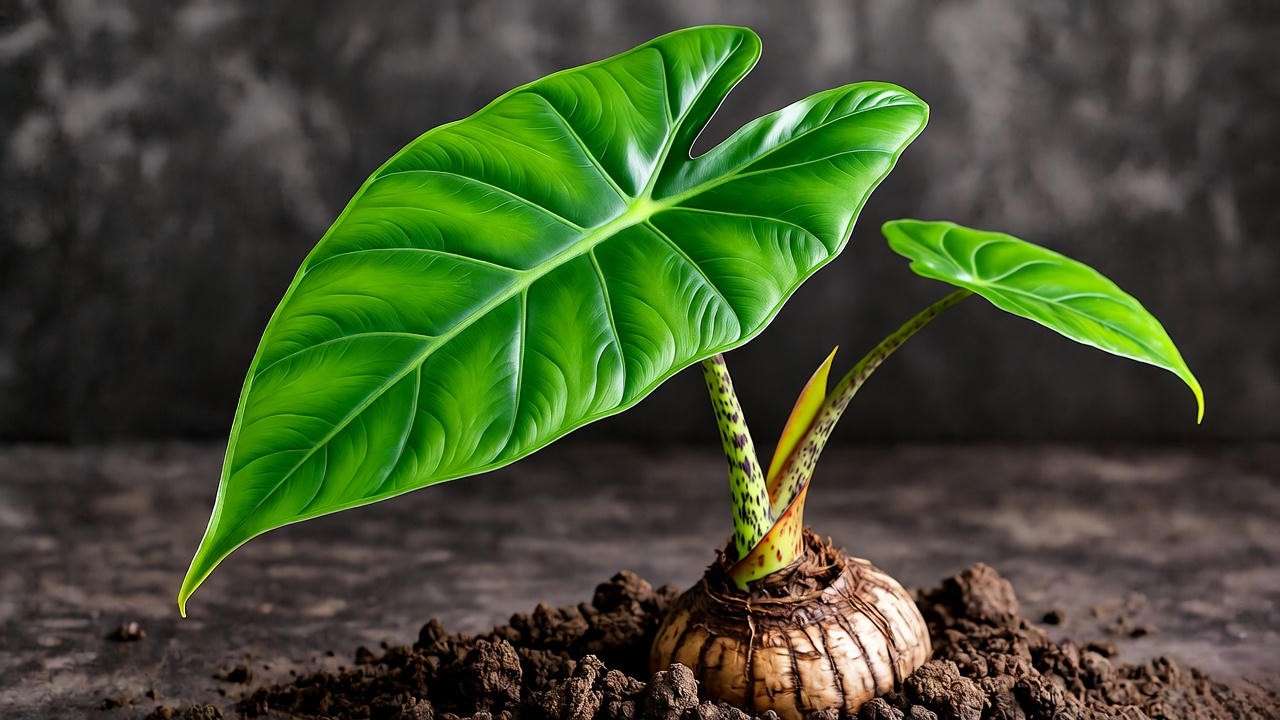
💧 Section 2: Watering, Soil, and Drainage — The Root of All Problems
If your Stingray Plant is droopy or its leaves are yellowing, 9 times out of 10, the problem lies in the soil and your watering strategy. Mastering this section is the key to Alocasia success.
H2: The Golden Rule: Moist, Not Soggy (Preventing Root Rot)
Alocasias hate extremes. They cannot tolerate drying out completely, but they also absolutely cannot tolerate sitting in stagnant, waterlogged soil. Root rot is the number one killer of this species.
- H3: The Perfect Watering Schedule (Beyond “Once a Week”) Forget calendar-based watering. Your schedule must be driven by the substrate’s moisture level and the surrounding environment.
- Expert Tip: The Knuckle Test: Water only when the top 1 to 2 inches (5 cm) of soil feel completely dry to the touch. Stick your finger into the soil up to your second knuckle. If it’s dry, it’s time to water thoroughly until water runs freely from the drainage holes.
- The Lift Test: For smaller pots, learn the weight of the pot when it is fully watered versus when it is dry. This provides a quick, accurate measurement.
- Seasonal Adjustment: The plant is a heavy drinker during its active growing season (Spring and Summer) and will require more frequent watering. During the winter (dormant season), cut back watering dramatically, often allowing the soil to dry halfway through the pot before adding a minimal amount of water.
- H3: Guttation: Reading Your Plant’s Signals You may notice small drops of clear water weeping from the tips of the Stingray’s leaves, usually in the morning. This process is called guttation. It occurs when the plant has taken up more water than it can transpire. While normal, consistent, heavy guttation is a clear sign of over-saturation. It indicates the soil is too dense or you are watering too frequently, and the roots need more air.
- H3: The Ultimate Stingray Soil Mix (E-E-A-T Focus) 🥣 The need for chunky, aerobic, and fast-draining substrate cannot be overstated. Standard commercial potting soil is a death trap for Alocasias because it holds too much water and compacts quickly, suffocating the delicate roots and corm.
- The Need for Chunkiness: The ideal potting medium mimics rainforest floor litter—it must be porous to allow air (oxygen) to reach the roots while still retaining enough ambient moisture for hydration.
- The Recipe: To create this expert-level Aroid mix, use the following ratio:
- 1 part high-quality Aroid potting mix or Coco Coir (The base for nutrients/moisture retention).
- 1 part Perlite or Pumice (Crucial for aeration and drainage).
- 1 part Orchid Bark, Leca, or Horticultural Charcoal (Adds significant chunkiness and helps prevent compaction).
- LSI Keywords: Aroid mix, chunky soil, aeration, coco coir, pumice, root rot prevention.
- H3: Pot Choice and Drainage System Always choose a container with sufficient drainage holes. For most Alocasias, a standard plastic nursery pot placed inside a decorative cachepot is ideal.
- The Debate on Pot Size: Alocasias prefer to be slightly root-bound. Avoid the common mistake of oversizing the pot. A pot that is too large holds an excessive amount of soil and moisture, which dramatically increases the risk of root rot. Repot only when roots are clearly circling or popping out of the drainage holes.
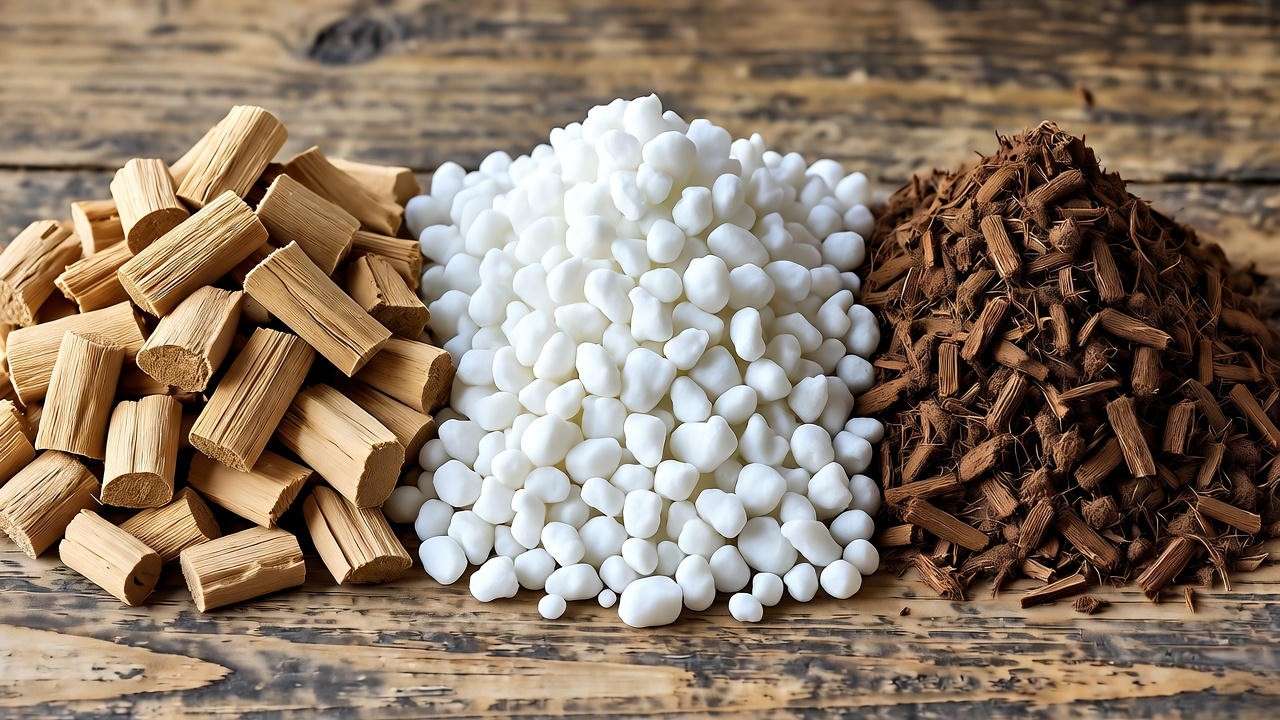
☀️ Section 3: Light, Warmth, and Humidity — Creating the Jungle Microclimate
The Stingray Plant is a tropical native, meaning it needs more than just water; it needs a specific climate. Getting the light and humidity right is what separates a four-leaf plant from a genuine thriving specimen.
H2: Optimizing Environmental Factors for Rapid Growth 🌱
- H3: Lighting Requirements: Bright, Filtered Bliss The Stingray requires significant light to support its large, energy-intensive leaves, but it must be filtered.
- Best Placement: An East-facing window (which provides gentle morning sun) or a few feet back from a South or West-facing window (where the intense afternoon light is diffused).
- The Danger of Direct Sun: Intense, direct sunlight will quickly scorch the delicate leaves, causing unsightly brown or bleached patches.
- Low Light Symptoms: In contrast, inadequate light will cause the plant to stretch (etiolation) and produce small, pale leaves, or worse—it will drop older leaves rapidly in a desperate attempt to conserve energy.
- Using Grow Lights: For consistent, year-round growth, especially in dark winter months, supplement with full-spectrum LED grow lights for 10-14 hours per day.
- H3: Humidity is Non-Negotiable (The 60% Solution) 💧 Low humidity is public enemy number two (after poor drainage) for the Stingray and is the single biggest cause of crispy leaf edges.
- Why low humidity causes crispy tips and attracts pests (spider mites). The dry, still air of most homes is the ideal breeding ground for these microscopic pests.
- Expert Solutions:
- Humidifiers (Most Effective): Place a cool-mist humidifier near your plant to maintain ambient humidity levels above 60%. This is the most reliable solution.
- Grouping Plants: Plants release moisture through transpiration. Grouping several tropical plants together creates a localized microclimate with higher humidity.
- Pebble Trays: Place the pot (ensuring the base is not sitting in the water) on a tray of water and pebbles. The evaporating water increases local humidity. (Misting is generally discouraged as it provides only a momentary boost and can promote fungal growth on leaves).
- H3: Temperature Zones (Avoiding the Chill) As a tropical plant, the Stingray is highly sensitive to cold.
- Ideal Range: The perfect indoor temperature is between 65°F to 80°F (18°C to 27°C).
- Warning: Cold drafts from windows, doors, or air conditioners, and temperatures consistently below 60°F (15°C), are immediate stressors. Exposure to cold can trigger rapid leaf yellowing and force the corm into sudden dormancy instantly. Always place your Alocasia far away from vents and exterior doors during the winter.
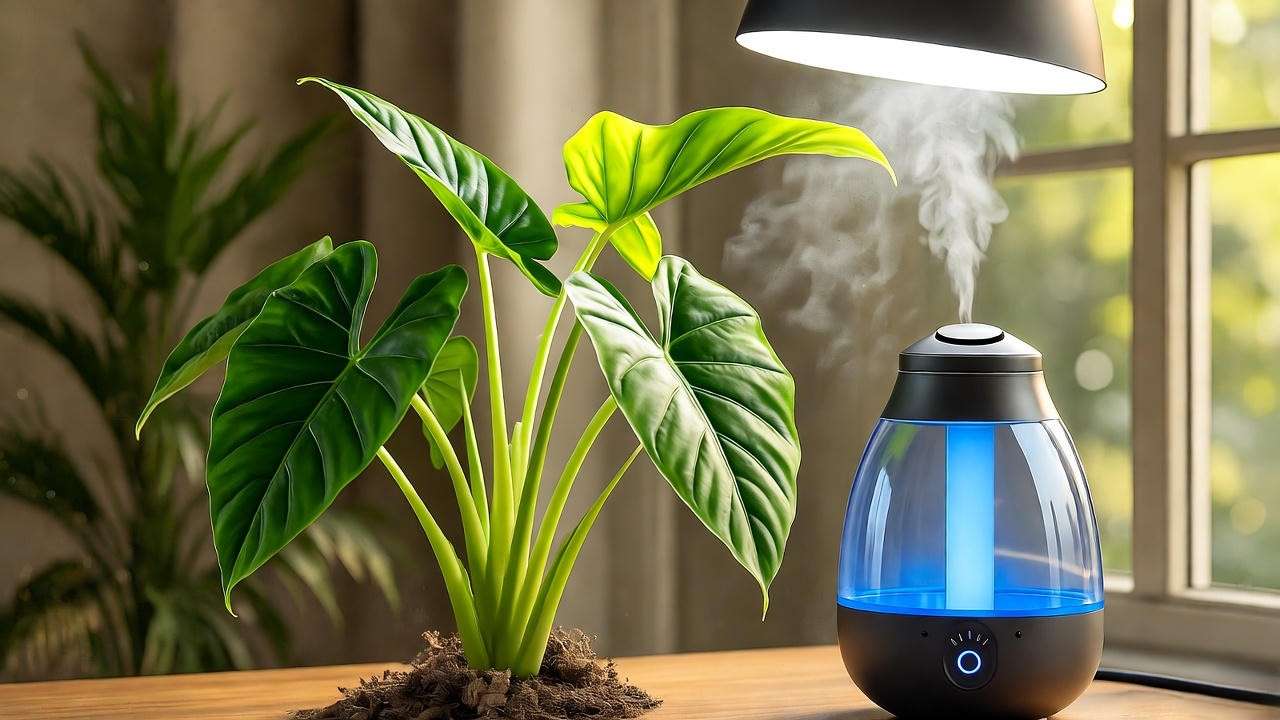
⚠️ Section 4: Troubleshooting the Drama — Why Stingray Leaves Droop 😢
This is the core problem addressed by the search intent. Stingray leaves drooping is a classic symptom of environmental stress. Here is the expert guide to diagnosing the cause.
H2: The Secret to Strong Leaves: Diagnosing the Alocasia Droop
- H3: Cause 1: Thirst vs. Overwatering (The Tightrope Walk) Both extremes cause leaves to droop, but the symptoms differ:
- Drooping from Thirst (Underwatered): The leaf stems and petioles appear limp, but the leaves themselves are often still green. The soil is bone dry. This is rapid and completely reversible if watered immediately.
- Drooping from Overwatering (Root Rot): Drooping is usually accompanied by leaves that start to turn yellow or even look mushy and develop dark spots. The soil is persistently wet. This is slow, systemic, and dangerous. Solution: Immediately stop watering, remove the plant from the pot, inspect the roots, and cut away any black, slimy, or foul-smelling roots. Repot into fresh, chunky Aroid mix.
- H3: Cause 2: The “One Leaf In, One Leaf Out” Rule 🔄 If your plant has a limited leaf count (often 3 to 5), and one leaf is yellowing and drooping as a new leaf is emerging, this is usually normal.
- Explanation: Alocasias, especially when juvenile or pot-bound, operate on an energy budget. They must sacrifice an older, less efficient leaf to redirect energy toward developing a large, perfect new leaf.
- Action Plan: If the plant is pushing new growth, and only the oldest/lowest leaf is dying, the droop is normal. Don’t panic! Cut the dying leaf off at the base of the petiole (stem) with sterilized shears once it is fully yellowed to help the plant conserve energy. As the plant matures and the corm grows larger, it will eventually support a higher leaf count.
- H3: Cause 3: Dormancy and Shock (Environmental Stress) Sudden, significant changes—like a drop in temperature, moving from a humid store to a dry home, or severe dehydration—can induce shock.
- The Result: The plant may drop all its leaves (go completely bare).
- Action Plan: If this happens, do not throw the plant away. Cut the remaining stalks down to the soil line. Keep the corm in its pot in a warm, dry location and water it minimally (maybe once a month) until temperatures rise and new growth begins to emerge, signaling it has come out of dormancy.
- H3: The Dreaded “Death Plug” (A Seller’s Secret) This is an expert insight often missed in general care guides. Many nursery-grown Alocasias are potted with a peat plug or net mesh surrounding the corm.
- The Problem: This plug retains too much moisture and eventually strangles the roots, leading to slow death or root rot.
- Expert Insight: If you buy a new Stingray, plan to check for and carefully remove this plug during its first repotting. This small action can prevent years of mysterious decline.
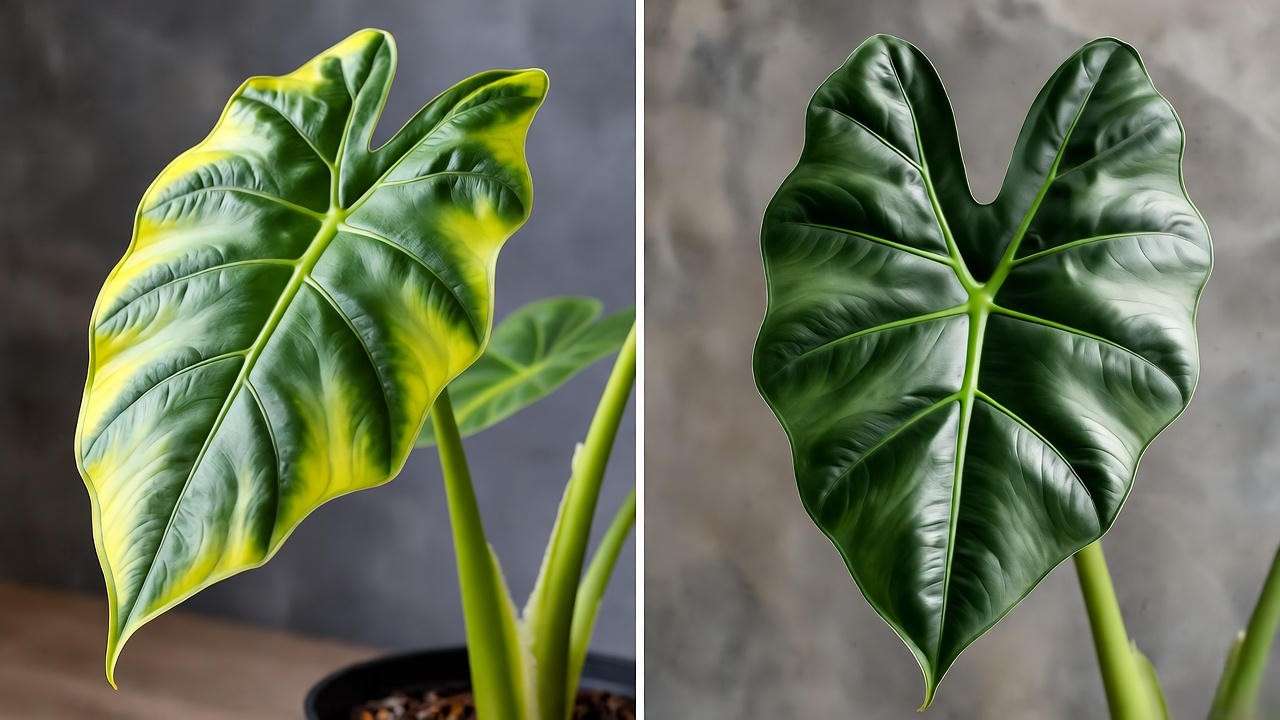
🛠️ Section 5: Advanced Care and Maintenance
To elevate your Stingray from merely surviving to absolutely flourishing, these advanced techniques are essential.
H2: Fueling Your Stingray: Feeding, Repotting, and Pest Prevention
- H3: Fertilization: Feeding a Heavy Eater Because of their rapid growth and large leaves, Stingrays are nutrient-hungry, especially during the spring and summer.
- Schedule: Use a balanced, diluted liquid fertilizer (1/4 to 1/2 strength) every 2 to 4 weeks during the growing season (March through September).
- CRITICAL: Never fertilize a dry, dormant, or distressed plant. Fertilizing when the roots are compromised or dry can lead to fertilizer burn, causing irreversible damage to the root system.
- H3: Repotting and Propagation (Corm Division)
- When to Repot: Repotting is only necessary when the plant is significantly root-bound, usually every 1 to 2 years. Always move up only one pot size (e.g., from 6-inch to 8-inch).
- Propagation (Corm Division): The only reliable way to propagate your Stingray is through the division of the main corm or by harvesting the small cormels (baby bulbs) that grow attached to the main plant. Gently separate these corms during repotting and plant them in a small pot with moist, chunky soil, providing high humidity and warmth to encourage sprouting.
- H3: Pest Management: The Spider Mite Magnet 🕷️ Alocasias are notorious targets for spider mites, tiny arachnids that thrive in the same low-humidity, warm environments that stress your plant.
- Symptom: Look for fine webbing on the leaf undersides and tiny dots (speckling) on the leaves.
- Prevention Strategy: The best defense is high humidity (60%+) and regular inspection. Wipe down the undersides of the leaves with a damp cloth every 1-2 weeks.
- Treatment: Use horticultural oil, insecticidal soap, or Neem oil applied meticulously to the entire plant (top and bottom of all leaves and stems). Repeat every 5-7 days until the infestation is gone.
❓ Section 6: Stingray Plant FAQs and Expert Insights
H2: Quick Answers for Common Stingray Plant Confusion
- H3: Quickfire Q&A
- “Is my Stingray plant dormant?” If all leaves are gone, gently feel the corm below the soil. If it is firm and solid, it is dormant. If it is soft or squishy, it has likely rotted. A dormant plant is only resting; a rotted corm is dead.
- “Why are the leaf edges turning brown and crispy?” This is the classic symptom of low humidity. The plant is losing moisture faster than its roots can supply it. Solution: Increase the ambient humidity, usually with a humidifier.
- “How big can a Stingray Alocasia actually get indoors?” While the species Alocasia macrorrhizos can become massive (6-10 feet tall), the ‘Stingray’ cultivar typically reaches a manageable indoor height of 3 to 5 feet, depending on the pot size and light availability.
- H3: Expert Insight: The Difference Between Stingray and Giant Taro (A. macrorrhizos) It’s important to clarify that while the Stingray is a cultivar of the Giant Taro, its specialized leaf structure makes it more susceptible to humidity issues and environmental shock than its robust parent. Treat the ‘Stingray’ as a delicate specimen plant that requires stable conditions and premium chunky soil, rather than the hardy, bog-loving Taro often grown outdoors.
🎉 Conclusion: The Reward for Patience
H2: Enjoying Your Thriving Stingray 💚
Caring for the Alocasia macrorrhizos ‘Stingray’ is undoubtedly a challenge, but the reward is a living sculpture of unparalleled botanical beauty. When you understand its native environment, the reasons behind its “drama” become clear and manageable.
- Summary: Success with this species boils down to three keys: Chunky, Aerobic Soil (for drainage), High Humidity (60%+), and Consistent Watering (never completely dry, never soggy).
- Final Encouragement: Acknowledge that Alocasias are high-maintenance, but by focusing on these core elements and recognizing its natural growth cycles, you can move past the constant droop and yellowing to enjoy this truly spectacular tropical plant.
We hope this comprehensive guide provides the expertise and confidence you need to grow a magnificent Stingray.
If you found this advice helpful, let us know! Would you like to dive deeper into pest prevention techniques or get a visual guide on inspecting the corm for dormancy? Share your Stingray challenges below!

